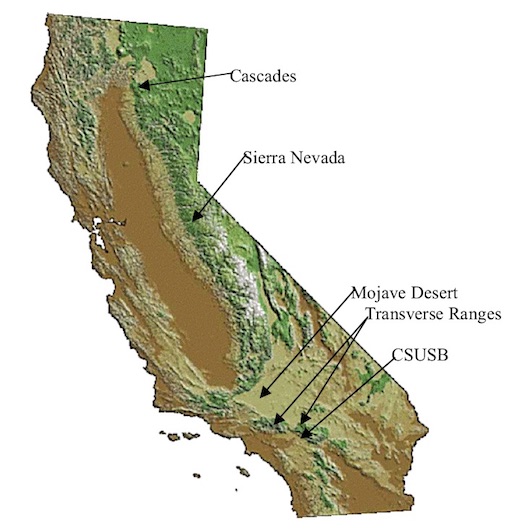Why so many species?
Part of the reason for the diversity of plant species in California is the wide diversity of climates and soil types that exist in California. This creates different environments that support different species.
Factors affecting climate:
Climate varies with latitude, altitude, proximity to the ocean, and placement of mountains with respect to prevailing winds.
- California covers a wide range of latitudes. It is cooler toward the poles (in this case, north) because sunlight strikes the Earth less directly at higher latitudes.
- California has numerous mountain ranges. It is cooler at higher elevations because air is always moving, rising air expands, and expanding air cools.
The mountains also cast rain shadows, creating a relatively wet area on the windward side of the mountain and a dry area (the rainshadow) on the leeward side of the mountain:

Rainshadows are caused when air is forced over mountains. As air travels up the windward side, it cools. As it cools, water condenses out of it, and it tends to rain on the windward side. The air descending the leeward side is relatively dry (having dropped its moisture already on the windward side). This causes the area on the leeward side of the mountain to be relatively dry. The Great Basin is a huge rainshadow between the Sierras and the Rocky Mountains.
The ocean along the coast of California moderates temperature swings. The cold current coming from the north along the coast also produces fogs. These fogs are observed in the summer in southern California and are very pronounced along the northern coast where you find redwood forests.
Climates of California
 The line of mountains formed by the Cascades, the Sierra Nevada, and the transverse ranges, separates "cismontane" California from "transmontane" California. The cismontane region is on the west side of this dividing line, toward the ocean. Most of this region has a Mediterranean climate (described below). The transmontane region, in a rainshadow, is drier and is desert (cold desert or hot desert, depending on latitude). The highest elevations in California, with coldest temperatures, may be classified as having a type of highland climate.
The line of mountains formed by the Cascades, the Sierra Nevada, and the transverse ranges, separates "cismontane" California from "transmontane" California. The cismontane region is on the west side of this dividing line, toward the ocean. Most of this region has a Mediterranean climate (described below). The transmontane region, in a rainshadow, is drier and is desert (cold desert or hot desert, depending on latitude). The highest elevations in California, with coldest temperatures, may be classified as having a type of highland climate.
A mediterranean climate
Mediterranean climates are sometimes described as having mild, moist winters and sometimes described as having cool, moist winters. They are always described as having a summer drought.

In the grand scheme of things, winter temperatures are mild; snow is rare. However, from the plant's perspective, a Mediterranean climate presents a challenge because, when temperatures are warm enough for rapid growth, water is rarely available, and when water is available for growth, temperatures are too low for rapid growth. Typically, a lot of the growth in this climate takes place in the spring, as temperatures begin to warm up, but before the soil water has disappeared. Germination of annuals may occur with the first rains of fall, but plants generally remain small and don't grow rapidly until temperatures warm up in the spring.
Soil
Soils vary in fertility, in the amount of water they can hold, and in the potentially stressful elements they contain (e.g., salts and heavy metals). California contains a wide variety of soil types, from thin rocky soils on steep mountain sides, to deep alluvial soils that have accumulated in valleys (and support some of the most productive agriculture on Earth), to salt flats in the desert, and serpentine soils near faults (which have high levels of heavy metals and low nutrients). Since different plant species have different abilities to cope with different conditions and stressors, this soil variation contributes to the fact that California contains many plant species.